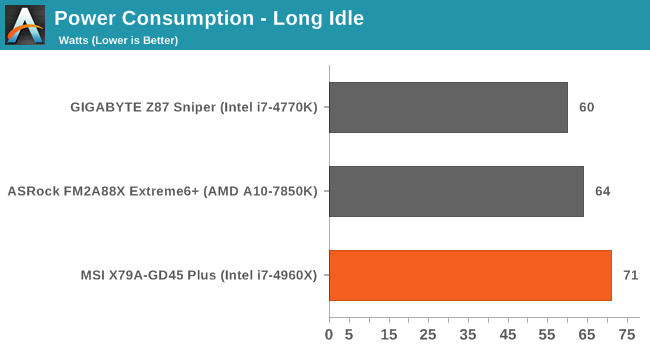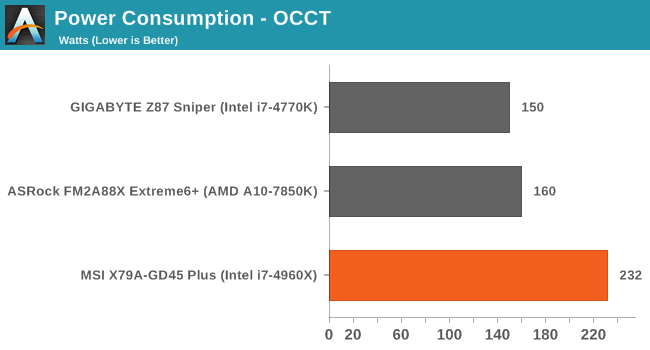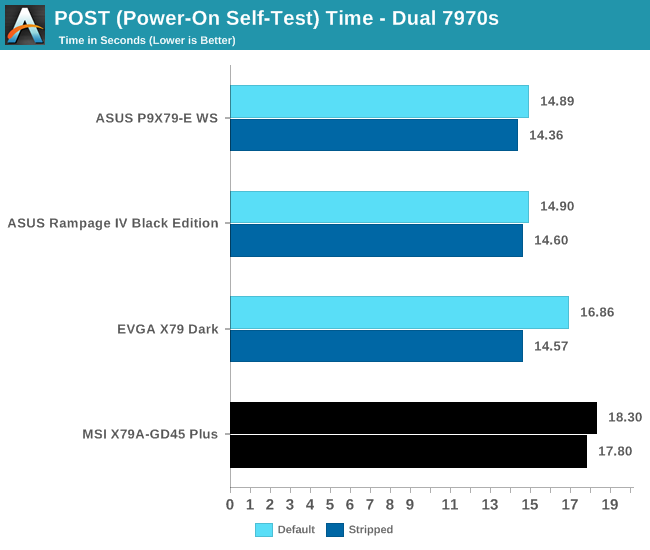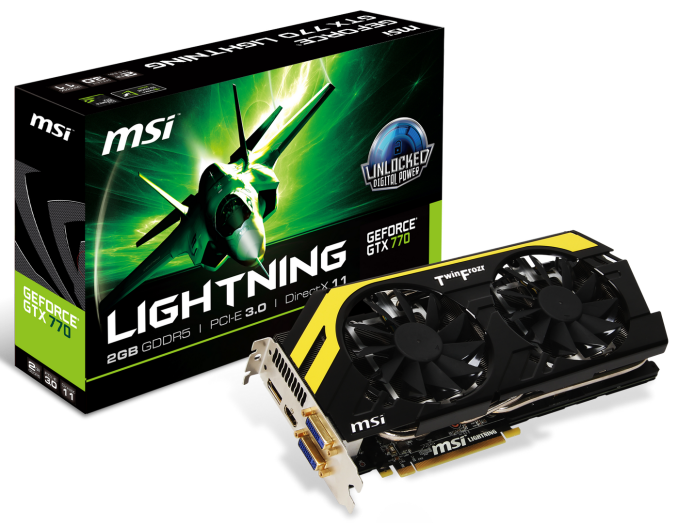MSI X79A-GD45 Plus Review: Building Up
by Ian Cutress on February 14, 2014 10:00 AM EST- Posted in
- Motherboards
- Intel
- MSI
- X79
2014 Test Setup
For 2014, the motherboard section has an upgrade in terms of testing hardware and benchmarks. The most significant upgrade for the test bed is on the GPU side, where we are moving from a pair of ECS GTX 580 GPUs to a trio of MSI GTX 770 Lightning models. We would like to thank MSI for this upgrade, which stands to be part of the motherboard test bed for several years to come.
The MSI GTX 770 Lightning is one of the fastest GTX 770 models available, being PCIe 3.0 compatible, having 1536 CUDA Cores at 1150 MHz (Boost 1202 MHz) and 2GB GDDR5 memory at 1750 MHz. Each card has two DVI outputs, a HDMI 1.4a and a DisplayPort 1.2. The card also has a GPU Reactor on the rear to help with overclocking by providing a cleaner power supply, and retails for ~$480.
More information can be found in Ryan’s MSI GTX 770 Lightning review.
Also in our testing, we are implementing 1080p for the gaming benchmarks, switching down from 2560x1440 due to popular request. The benchmark suite is also being updated, including the following new tests:
Adobe Effects CS6
Agisoft Photoscan 1.0
Handbrake v0.9.9
Dolphin Emulator Benchmark
All the other benchmarks included are either the same as previous, or updated to the latest version of the software to take advantage of any performance enhancements.
On the GPU side, the following games are now tested at 1080p maximum settings:
F1 2013
Sleeping Dogs
Tomb Raider
Bioshock Infinite
Company of Heroes 2
Both F1 2013 and CoH 2 unfortunately do not scale beyond a single GPU, and we are still working on a BF4 benchmark which was unfortunately not ready for this review; however it looks like the rail run at the beginning of the Tashgar mission will be used in future.
Other changes include the power testing, which will focus on a single GTX 770, and the POST time which will (after this review) also be with a single GTX 770 installed to gain parity between smaller form factor motherboards. Unfortunately this means that a lot of our older results are no longer valid for this review, and we have included the results of a number of future reviews to provide comparison points.
Many thanks to...
We must thank the following companies for kindly providing hardware for our test bed:
Thank you to OCZ for providing us with 1250W Gold Power Supplies and SSDs.
Thank you to G.Skill and ADATA for providing us with memory kits.
Thank you to Corsair for providing us with an AX1200i PSU, Corsair H80i CLC and 16GB 2400C10 memory.
Thank you to ASUS for providing us with the AMD HD7970 GPUs and some IO Testing kit.
Thank you to MSI for providing us with the NVIDIA GTX 770 Lightning GPUs.
Thank you to Rosewill for providing us with the 500W Platinum Power Supply for mITX testing, BlackHawk Ultra, and 1600W Hercules PSU for extreme dual CPU + quad GPU testing, and RK-9100 keyboards.
Thank you to ASRock for providing us with the 802.11ac wireless router for testing.
Test Setup
| Test Setup | |
| Processor |
Intel Core i7-4960X ES 6 Cores, 12 Threads, 3.6 GHz (4.0 GHz Turbo) |
| Motherboards | MSI X79A-GD45 Plus |
| Cooling |
Corsair H80i Thermalright TRUE Copper |
| Power Supply |
OCZ 1250W Gold ZX Series Corsair AX1200i Platinum PSU |
| Memory |
G.Skill RipjawsZ 4x4 GB DDR3-1866 8-9-9 Kit 2 x Corsair Vengeance Pro 2x8 GB DDR3-2400 10-12-12 Kit |
| Memory Settings | XMP |
| Video Cards |
MSI GTX 770 Lightning 2GB (1150/1202 Boost) ASUS HD7970 3GB (Reference) |
| Video Drivers |
Catalyst 13.12 NVIDIA Drivers 332.21 |
| Hard Drive | OCZ Vertex 3 256GB |
| Optical Drive | LG GH22NS50 |
| Case | Open Test Bed |
| Operating System | Windows 7 64-bit SP1 |
| USB 2/3 Testing | OCZ Vertex 3 240GB with SATA->USB Adaptor |
| WiFi Testing | D-Link DIR-865L 802.11ac Dual Band Router |
Power Consumption
Power consumption was tested on the system as a whole with a wall meter connected to the OCZ 1250W power supply, while in a dual AMD HD 7970 configuration. This power supply is Gold rated, and as I am in the UK on a 230-240 V supply, leads to ~75% efficiency > 50W, and 90%+ efficiency at 250W, which is suitable for both idle and multi-GPU loading. This method of power reading allows us to compare the power management of the UEFI and the board to supply components with power under load, and includes typical PSU losses due to efficiency. These are the real world values that consumers may expect from a typical system (minus the monitor) using this motherboard.
While this method for power measurement may not be ideal, and you feel these numbers are not representative due to the high wattage power supply being used (we use the same PSU to remain consistent over a series of reviews, and the fact that some boards on our test bed get tested with three or four high powered GPUs), the important point to take away is the relationship between the numbers. These boards are all under the same conditions, and thus the differences between them should be easy to spot.



Due to our limited testing of the 2014 suite, it was perhaps obvious that the 4960X platform would draw more power than either the i7-4770K or A10-7850K platforms.
Windows 7 POST Time
Different motherboards have different POST sequences before an operating system is initialized. A lot of this is dependent on the board itself, and POST boot time is determined by the controllers on board (and the sequence of how those extras are organized). As part of our testing, we are now going to look at the POST Boot Time - this is the time from pressing the ON button on the computer to when Windows 7 starts loading. (We discount Windows loading as it is highly variable given Windows specific features.) These results are subject to human error, so please allow +/- 1 second in these results.

The POST time of the MSI was longer than expected, coming last in our comparison to the other X79 boards we have tested with Ivy Bridge-E.












44 Comments
View All Comments
hulu - Friday, February 14, 2014 - link
In Board Features > Memory Slots, says "Up to Dual Channel". Shouldn't it be quad channel?dgingeri - Friday, February 14, 2014 - link
Well, it could be useful for a high level home server with that many slots. Put a low end video card in the top, raid controller in the second, quad port 1Gb NICs in the 4th and 5th, and have the last slot available for a 10Gb card if needed. Wouldn't even need a switch to go with it. All in one, storage, network, routing, high end network. It has possibilities.Rick83 - Friday, February 14, 2014 - link
But most of that you can do with 1155, and for that price you can get a board with ECC support to boot, won't need any GPU at all (unless you get a Xeon that has the GPU disabled), and still have plenty room to grow. 1155 has plenty of PCIe bandwidth, as long as most of your load is from two expansion slots. Hooking up RAID and networking directly to the CPU means that you will have two or three expansion cards that may eventually be bandwidth restrained, but even then opting for a board with a PCIe MUX would be in the same league, price-wise as this, and have plenty of bandwidth for up to four cards - and most non-GPU cards aren't really PCIe restricted. Quad GbE is one lane PCIe3, 10GbE is 2-4 lanes, 8x 6Gb SAS with software RAID over SSDs is going to need 8x PCIeV3, but realistically 4x is going to be enough, if you use hardware RAID or spinning platters.No, the only reason for this board, is if you want a cheap rendering machine. 6-8 cores and 64GB of RAM on a 250 dollar board is pretty nice. If you want gaming, you'll probably be looking at boards higher up the foodchain, as the GPUs alone will come in at around 2-3k dollars, and another 100 on the board won't really matter, if you get better sound and other nifty features.
GPU computer might be another use case, but then that's even rarer than rendering boxes, from what I've seen so far. Might be a nice little GPU compute dev workstation.
Flunk - Friday, February 14, 2014 - link
There really isn't any need for this as a home server. It's total overkill. Even a Core 2 Quad can transcode multiple 1080p streams while serving files, routing and doing all the other common home server tasks. Home servers don't really need much power, most homes don't have more than 4-6 users.dgingeri - Friday, February 14, 2014 - link
For total I/O and a poor man's 10Gbe switch, socket 2011 or 1366 can't be beat. That's what I mostly use my home servers for. Socket 775, 1155, or 1150 systems simply can't provide the I/O to run a software switch that includes 10Gbe.Yeah, sure, 10Gbe is hardly worth the expense in a home server. However, with a raid controller and quad drive set capable of pushing 400MB/s, it can be useful for video editing over a network drive, or a few other things.
I do it as an experiment on future uses and self training. Right now, I have three servers interconnected with 10Gb over such a poor man's 10Gbe switch running a total of 14 VMs over 3 domains with 6 domain controllers, 3 WDS servers, and some 'workstations', just to prove I could do it before I propose doing the same thing with the DNS servers in my lab. (We currently have 4 domains across 17 departments, with 3 of those 4 running Linux DNS servers that don't talk to each other. It's really annoying working on machines that cross those domains. So, I had to come up with a plan to fix it with Windows DNS and AD, and eventually migrate down to one domain. In addition, I was to come up with a way to manage user accounts through Windows AD for a single centralized vCenter server to manage our test VM hosts. I wasn't sure I could do it until I spent a weekend building all these VMs.) All of those VMs are running on iSCSI storage over 10Gbe from the storage server. I did all this with two Dell T110 II servers, one for storage and one for routing/switch, and a piecemeal FX-6100 VM host and 4 Intel CX4 10Gbe NICs.
In essence, I was just dreaming about a more capable central server for my experiments when I posted that previous comment. I could switch the storage and switch duties to a system with this board and use the Dells as further VM hosts. Maybe I'm just spoiled with all this hardware at work.
Ian Cutress - Friday, February 14, 2014 - link
Copy/Paste error from my spec tables which I hand code to make it easier :) Should be fixed.Ian
Bal - Friday, February 14, 2014 - link
Ok I am not one to criticize articles, but this reads REALLY poorly. I mean I am the guy who misspells every other word and uses slang, misses apostrophes etc. So I forgive everything as long as its readable. But I could not get past the first page of this review.The writer misuses "are" and "is" so often I have to reread every other sentence. He completely misses using the word "the" and it also makes you reread each sentence. Read the first two paragraphs and someone tell me I am wrong? Am I just grumpy, hungover or what?
The PC Apologist - Friday, February 14, 2014 - link
Hahaha, you must be new to Ian. He's rather infamous for his "style."It would seem that eloquence is not as valued as passion when it comes to the tech journalism industry, even for Anandtech. Refer to the 14 AIO coolers article and its comments section to see an excellent example of what I mean. There I had a little exchange with the author and boy, it’s not pretty.
Although one could say that one doesn’t read a motherboard review, or any other tech article, to brush up on one’s English grammar or writing skills, but rather just to look at some pretty pictures, learn the price/specs, and read the conclusion, it’s somewhat of a weak cop-out as one would also expect AnandTech to strive for higher standards. Reading is reading and a poorly written article is a poorly written article, regardless of topic. Other sites aren’t much better though. And to their defense, there are some decent writers, in terms of pure writing, here at AnandTech, not least of which is Anand himself. And who knows? I might even answer AnandTech’s Call for Writers one of these days. So fret not, all hope is not lost.
- The PC Apologist
thesavvymage - Saturday, February 15, 2014 - link
I would absolutely loathe you writing for this site. I'm sure the other writers would hate you writing with them as well, pretty much every time I see you in the comments it is because you are complaining of the competence of the english and grammar of the article.BlakKW - Saturday, February 15, 2014 - link
+1